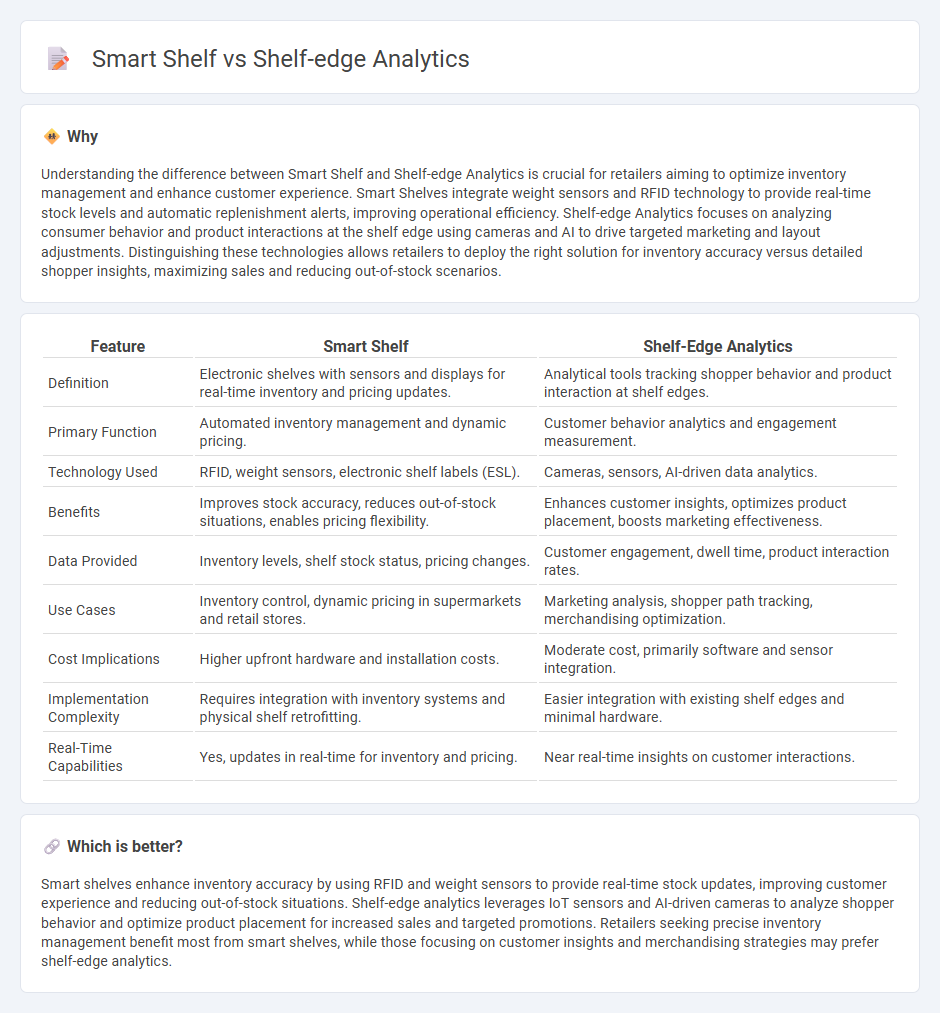
Smart shelves integrate RFID and weight sensors to provide real-time inventory tracking, enhancing stock accuracy and reducing out-of-stock incidents. Shelf-edge analytics utilize digital price tags and embedded cameras to analyze shopper behavior and optimize pricing strategies dynamically. Explore how these technologies transform retail efficiency and customer experience.
Why it is important
Understanding the difference between Smart Shelf and Shelf-edge Analytics is crucial for retailers aiming to optimize inventory management and enhance customer experience. Smart Shelves integrate weight sensors and RFID technology to provide real-time stock levels and automatic replenishment alerts, improving operational efficiency. Shelf-edge Analytics focuses on analyzing consumer behavior and product interactions at the shelf edge using cameras and AI to drive targeted marketing and layout adjustments. Distinguishing these technologies allows retailers to deploy the right solution for inventory accuracy versus detailed shopper insights, maximizing sales and reducing out-of-stock scenarios.
Comparison Table
| Feature | Smart Shelf | Shelf-Edge Analytics |
|---|---|---|
| Definition | Electronic shelves with sensors and displays for real-time inventory and pricing updates. | Analytical tools tracking shopper behavior and product interaction at shelf edges. |
| Primary Function | Automated inventory management and dynamic pricing. | Customer behavior analytics and engagement measurement. |
| Technology Used | RFID, weight sensors, electronic shelf labels (ESL). | Cameras, sensors, AI-driven data analytics. |
| Benefits | Improves stock accuracy, reduces out-of-stock situations, enables pricing flexibility. | Enhances customer insights, optimizes product placement, boosts marketing effectiveness. |
| Data Provided | Inventory levels, shelf stock status, pricing changes. | Customer engagement, dwell time, product interaction rates. |
| Use Cases | Inventory control, dynamic pricing in supermarkets and retail stores. | Marketing analysis, shopper path tracking, merchandising optimization. |
| Cost Implications | Higher upfront hardware and installation costs. | Moderate cost, primarily software and sensor integration. |
| Implementation Complexity | Requires integration with inventory systems and physical shelf retrofitting. | Easier integration with existing shelf edges and minimal hardware. |
| Real-Time Capabilities | Yes, updates in real-time for inventory and pricing. | Near real-time insights on customer interactions. |
Which is better?
Smart shelves enhance inventory accuracy by using RFID and weight sensors to provide real-time stock updates, improving customer experience and reducing out-of-stock situations. Shelf-edge analytics leverages IoT sensors and AI-driven cameras to analyze shopper behavior and optimize product placement for increased sales and targeted promotions. Retailers seeking precise inventory management benefit most from smart shelves, while those focusing on customer insights and merchandising strategies may prefer shelf-edge analytics.
Connection
Smart shelves utilize embedded sensors and RFID technology to collect real-time inventory data, while shelf-edge analytics processes this data to optimize stock levels and enhance product placement strategies. Together, they enable retailers to improve shelf management, reduce out-of-stock situations, and personalize the shopping experience through data-driven insights. This integration supports dynamic pricing and targeted promotions, maximizing sales efficiency and customer satisfaction.
Key Terms
Real-time inventory monitoring
Shelf-edge analytics enable real-time inventory monitoring through sensors and data processing at the shelf level, providing immediate visibility into stock levels and customer interactions. Smart shelves integrate advanced IoT technology and AI algorithms to automate inventory tracking and optimize shelf restocking, reducing out-of-stock incidents and enhancing operational efficiency. Explore the latest advancements in retail technology to maximize inventory accuracy and boost sales performance.
Customer engagement
Shelf-edge analytics leverage real-time data from shelf sensors and displays to monitor customer interactions and optimize product placement for increased engagement. Smart shelves integrate IoT technology and AI to provide personalized promotions and inventory updates, enhancing the shopping experience and driving higher customer satisfaction. Explore how these technologies transform retail environments to boost customer engagement and sales.
Data-driven merchandising
Shelf-edge analytics harnesses real-time data from price tags and sensor-enabled displays to optimize product placement and pricing strategies, increasing sales efficiency and customer engagement. Smart shelf technology integrates RFID and weight sensors to track inventory levels and consumer interactions, enabling precise stock management and tailored promotions. Explore in-depth the transformative impact of these innovations on data-driven merchandising strategies.
Source and External Links
Leveraging shelf edge analytics for smarter merchandising - Shelf-edge analytics collects near real-time data on product interactions and availability, helping retailers optimize promotions, improve inventory management, increase sales conversion rates, and reduce stockouts through data-driven decision making.
The Value of Shelf-Edge Technology - Shelf-edge technology integrates electronic shelf labels and digital displays to provide real-time inventory data, personalized pricing, and promotional offers directly at the shelf, enhancing customer engagement and operational efficiency for retailers.
How Retailers are Maximizing Sales at the Shelf Edge - Electronic Shelf Labels (ESLs) enable dynamic pricing, personalized promotions, and transparent product information, allowing retailers to swiftly respond to market changes, increase customer loyalty, and improve buying decisions at the point of sale.
 dowidth.com
dowidth.com